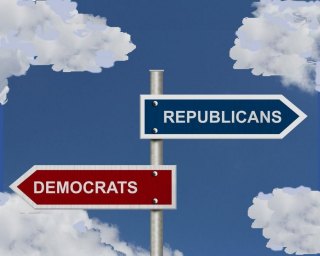Six findings about America's partisan rift

And so it goes. Americans have become more politically polarized during the past two decades, according to a study of 10,000 respondents conducted by the Pew Research Center from January through March of this year.
Common ground is a shrinking piece of real estate. Consider that 92 percent of Republicans are to the right of the median Democrat. Two decades ago, that figure was 64 percent. Among Democrats, 94 percent are to the left of the median Republican, up from 70 percent in 1994, the report said.
Here are six findings from the Pew report, Political Polarization in the American Public:
A “very unfavorable" view
We think more negatively of the opposition. In 1994, 16 percent of Democrats viewed Republicans very unfavorably; in 2014, 38 percent held this view. Similarly, in 1994, 17 percent of Republicans viewed Democrats very unfavorably; in 2014, 43 percent viewed Democrats very unfavorably.
Beyond dislike
Survey respondents who expressed an unfavorable impression of the other party were also asked: “Would you say the party’s policies are so misguided that they threaten the nation’s well-being, or wouldn’t you go that far?”
Many respondents were willing to go that far. Indeed, 27 percent of Democrats see Republicans as a “treat to the nation’s well-being,” while 36 percent of Republicans feel the same way about Democrats.
Either consistently liberal or conservative
In 2014, 12 percent of survey respondents said they were consistently liberal. In 1994, only 3 percent said they were consistently liberal.
Similarly, 9 percent of respondents said they were consistently conservative in 2014, but in 1994, 7 percent said they were consistently conservative.
Opposites don't attract
It’s not just that we don’t agree with the opposition. We don’t want to befriend them, either. Those with strong views – either conservative or liberal – want to be around people who feel likewise. “Nearly two-thirds (63 percent) of consistent conservatives and about half (49 percent) of consistent liberals say most of their close friends share their political views,” Pew reported.
On the upside, not many respondents said they would be upset if a family member married a person of a different political party. But those who were consistently liberal or consistently conservative were more likely to have a problem with an in-law of the opposite persuasion. Roughly 30 percent of consistent conservatives would be unhappy if an immediate family member married a Democrat, while 23 percent of consistent liberals said the same about the possibility of a Republican in-law.
The elusive center
The Pew Center charted responses to 10 “political values questions” asked on multiple surveys. In 2014, 39 percent of respondents gave an equal number of liberal and conservative positions. In 1994 and 2004, roughly 49 percent held an equal number of liberal and conservative positions.
Some agreement
Across the board, respondents agree that they want to live in a place close to extended family with high-quality schools. But that may be where the common ground ends. The survey found that 76 percent of liberals and 20 percent of conservatives say that it is important for a community to have racial and ethnic diversity.
On the flip side, 57 percent of conservatives and 17 percent of liberals want to live in a place where many people share their religious faith.
Related:
Congress: Were things ever any better?

